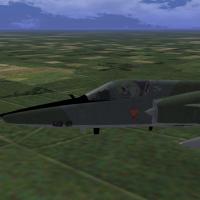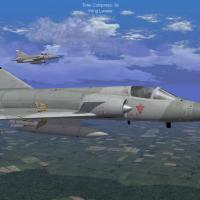Search the Community
Showing results for tags 'iii'.
Found 4 results
-

Mirage IIIRS
denissoliveira posted a topic in Thirdwire: Strike Fighters 2 Series - File Announcements
File Name: Mirage IIIRS File Submitter: denissoliveira File Submitted: 21 January 2017 File Category: Mirage 3 Swiss Mirage IIIRS Install - Need Update July 2012, DLC Mirage IIIO In 1961, Switzerland bought a single Mirage IIIC from France. This Mirage IIIC was used as development aircraft. The Swiss Mirages were built in Switzerland by F+W Emmen (today RUAG ) (the federal government aircraft factory in Emmen) as the Mirage IIIS. Australia too, bought, one French-made in preparation for licensed production. Cost overruns during the Swiss production led to the so-called "Mirage affair". In all, 36 Mirage IIIS interceptors were built with strengthened wings, airframe, and undercarriage. The Swiss Air Force required performance comparable to those of carrier based planes; the airframes were reinforced so the aircraft could be moved by lifting them over other aircraft with a crane, as in the Aircraft cavern in the mountains that Swiss Air Force uses as bunkers, offer very little space to maneuver parked aircraft. Also, the strengthened frames allowed for JATO assisted takeoffs. The main differences to the standard Mirage III were as follows: New wiring of avionics with U.S. electronics Changed cockpit design with gray instead of black panels New U.S. radar, TARAN-18 from Hughes Use of HM-55S "Falcon" (Swiss designation of the from SAAB in Licence built Robot 27 (Rb27) which is similar to the Hughes AIM-26 "Falcon") Radar warning receiver (RWR) on both wingtips and on the back of the rudder Strengthened structure for use of JATO-Rockets Retractable nosecone and lengthened nosewhlle leg for storing in underground air base Four lifting points for moving aircraft in underground caverns with a crane Bay at the fin with a SEPR rocket engine to double the velocity for short time or climb to 20 000 m (60 000 ft) US TRACOR AN/ALE-40 chaff/flare dispenser at the back under the end of the engine (fitted with the upgrade 1988) Canards designed and produced by RUAG Aerospace(fitted with the upgrade 1988) New Martin-Baker ejection-seat (fitted with the upgrade 1988) The Swiss Mirages are equipped with RWS, chaff & flare dispensers. Avionics differed as well, with the most prominent difference being that the Thomson-CSF Cyrano II radar was replaced by Hughes TARAN-18 system, giving the Mirage IIIS compatibility with the Hughes AIM-4 Falcon AAM. Also the Mirage IIIS had the wiring to carry a Swiss-built nuclear bomb or French nuclear bomb. The Swiss nuclear bomb was stopped in the preproduction stage and Switzerland did not purchase the French-made bomb. The Mirage IIIS had an integral fuel tank under the aft belly; this fuel tank could be removed and replaced with an adapter of the same shape. This adapter housed a SEPR rocket engine with its liquid fuel tanks. With the SEPR rocket, the Mirage IIIS easily reached altitudes of 20,000 m. The rocket fuel was very hazardous and highly toxic, so the SEPR rocket was not used very often. The Mirage IIIRS could also carry a photo-reconnaissance centerline pod and an integral fuel tank under the aft belly; this carried a smaller fuel load but allowed a back looking film camera to be added. In the early 1990s, the 30 surviving Swiss Mirage IIIS interceptors were put through an upgrade program, which included fitting them with fixed canards and updated avionics. The Mirage IIIS were phased out of service in 1999. The remaining Mirage IIIRS, BS and DS were taken out of Special thanks to Paulopanz and Coupi. Mirage IIIRS Modelo - TK (Mirage IIIO) Texture - Ludo, Denis Oliveira mod - Denis Oliveira Decals - Paulopanz Data.ini - Denis Oliveira, Coupi Cockpit 3D - Denis Oliveira Click here to download this file -
Version v3 (Final)
307 downloads
Swiss Mirage IIIRS Install - Need Update July 2012, DLC Mirage IIIO In 1961, Switzerland bought a single Mirage IIIC from France. This Mirage IIIC was used as development aircraft. The Swiss Mirages were built in Switzerland by F+W Emmen (today RUAG ) (the federal government aircraft factory in Emmen) as the Mirage IIIS. Australia too, bought, one French-made in preparation for licensed production. Cost overruns during the Swiss production led to the so-called "Mirage affair". In all, 36 Mirage IIIS interceptors were built with strengthened wings, airframe, and undercarriage. The Swiss Air Force required performance comparable to those of carrier based planes; the airframes were reinforced so the aircraft could be moved by lifting them over other aircraft with a crane, as in the Aircraft cavern in the mountains that Swiss Air Force uses as bunkers, offer very little space to maneuver parked aircraft. Also, the strengthened frames allowed for JATO assisted takeoffs. The main differences to the standard Mirage III were as follows: New wiring of avionics with U.S. electronics Changed cockpit design with gray instead of black panels New U.S. radar, TARAN-18 from Hughes Use of HM-55S "Falcon" (Swiss designation of the from SAAB in Licence built Robot 27 (Rb27) which is similar to the Hughes AIM-26 "Falcon") Radar warning receiver (RWR) on both wingtips and on the back of the rudder Strengthened structure for use of JATO-Rockets Retractable nosecone and lengthened nosewhlle leg for storing in underground air base Four lifting points for moving aircraft in underground caverns with a crane Bay at the fin with a SEPR rocket engine to double the velocity for short time or climb to 20 000 m (60 000 ft) US TRACOR AN/ALE-40 chaff/flare dispenser at the back under the end of the engine (fitted with the upgrade 1988) Canards designed and produced by RUAG Aerospace(fitted with the upgrade 1988) New Martin-Baker ejection-seat (fitted with the upgrade 1988) The Swiss Mirages are equipped with RWS, chaff & flare dispensers. Avionics differed as well, with the most prominent difference being that the Thomson-CSF Cyrano II radar was replaced by Hughes TARAN-18 system, giving the Mirage IIIS compatibility with the Hughes AIM-4 Falcon AAM. Also the Mirage IIIS had the wiring to carry a Swiss-built nuclear bomb or French nuclear bomb. The Swiss nuclear bomb was stopped in the preproduction stage and Switzerland did not purchase the French-made bomb. The Mirage IIIS had an integral fuel tank under the aft belly; this fuel tank could be removed and replaced with an adapter of the same shape. This adapter housed a SEPR rocket engine with its liquid fuel tanks. With the SEPR rocket, the Mirage IIIS easily reached altitudes of 20,000 m. The rocket fuel was very hazardous and highly toxic, so the SEPR rocket was not used very often. The Mirage IIIRS could also carry a photo-reconnaissance centerline pod and an integral fuel tank under the aft belly; this carried a smaller fuel load but allowed a back looking film camera to be added. In the early 1990s, the 30 surviving Swiss Mirage IIIS interceptors were put through an upgrade program, which included fitting them with fixed canards and updated avionics. The Mirage IIIS were phased out of service in 1999. The remaining Mirage IIIRS, BS and DS were taken out of Special thanks to Paulopanz and Coupi. Mirage IIIRS Modelo - TK (Mirage IIIO) Texture - Ludo, Denis Oliveira mod - Denis Oliveira Decals - Paulopanz Data.ini - Denis Oliveira, Coupi Cockpit 3D - Denis Oliveira -

Swiss Mirage III Pack
denissoliveira posted a topic in Thirdwire: Strike Fighters 2 Series - File Announcements
File Name: Swiss Mirage III Pack File Submitter: denissoliveira File Submitted: 13 January 2016 File Category: Mirage 3 Swiss Mirage III Pack Install - Need Update July 2012, DLC Mirage IIIO In 1961, Switzerland bought a single Mirage IIIC from France. This Mirage IIIC was used as development aircraft. The Swiss Mirages were built in Switzerland by F+W Emmen (today RUAG ) (the federal government aircraft factory in Emmen) as the Mirage IIIS. Australia too, bought, one French-made in preparation for licensed production. Cost overruns during the Swiss production led to the so-called "Mirage affair". In all, 36 Mirage IIIS interceptors were built with strengthened wings, airframe, and undercarriage. The Swiss Air Force required performance comparable to those of carrier based planes; the airframes were reinforced so the aircraft could be moved by lifting them over other aircraft with a crane, as in the Aircraft cavern in the mountains that Swiss Air Force uses as bunkers, offer very little space to maneuver parked aircraft. Also, the strengthened frames allowed for JATO assisted takeoffs. The main differences to the standard Mirage III were as follows: New wiring of avionics with U.S. electronics Changed cockpit design with gray instead of black panels New U.S. radar, TARAN-18 from Hughes Use of HM-55S "Falcon" (Swiss designation of the from SAAB in Licence built Robot 27 (Rb27) which is similar to the Hughes AIM-26 "Falcon") Radar warning receiver (RWR) on both wingtips and on the back of the rudder Strengthened structure for use of JATO-Rockets Retractable nosecone and lengthened nosewhlle leg for storing in underground air base Four lifting points for moving aircraft in underground caverns with a crane Bay at the fin with a SEPR rocket engine to double the velocity for short time or climb to 20 000 m (60 000 ft) US TRACOR AN/ALE-40 chaff/flare dispenser at the back under the end of the engine (fitted with the upgrade 1988) Canards designed and produced by RUAG Aerospace(fitted with the upgrade 1988) New Martin-Baker ejection-seat (fitted with the upgrade 1988) The Swiss Mirages are equipped with RWS, chaff & flare dispensers. Avionics differed as well, with the most prominent difference being that the Thomson-CSF Cyrano II radar was replaced by Hughes TARAN-18 system, giving the Mirage IIIS compatibility with the Hughes AIM-4 Falcon AAM. Also the Mirage IIIS had the wiring to carry a Swiss-built nuclear bomb or French nuclear bomb. The Swiss nuclear bomb was stopped in the preproduction stage and Switzerland did not purchase the French-made bomb. The Mirage IIIS had an integral fuel tank under the aft belly; this fuel tank could be removed and replaced with an adapter of the same shape. This adapter housed a SEPR rocket engine with its liquid fuel tanks. With the SEPR rocket, the Mirage IIIS easily reached altitudes of 20,000 m. The rocket fuel was very hazardous and highly toxic, so the SEPR rocket was not used very often. The Mirage IIIRS could also carry a photo-reconnaissance centerline pod and an integral fuel tank under the aft belly; this carried a smaller fuel load but allowed a back looking film camera to be added. In the early 1990s, the 30 surviving Swiss Mirage IIIS interceptors were put through an upgrade program, which included fitting them with fixed canards and updated avionics. The Mirage IIIS were phased out of service in 1999. The remaining Mirage IIIRS, BS and DS were taken out of Special thanks to Paulopanz and Coupi. Mirage IIIBS Mirage IIIS (Early) Mirage IIIS Mirage IIIDS Mirage IIIRS (Early) Mirage IIIRS Modelo - TK (Mirage IIIO) Texture - Ludo, Denis Oliveira mod - Denis Oliveira Decals - Paulopanz Data.ini - Denis Oliveira, Coupi Cockpit and Avioncs ini - Coupi, Denis Oliveira Click here to download this file -
Version v2.0
340 downloads
Swiss Mirage III Pack Install - Need Update July 2012, DLC Mirage IIIO In 1961, Switzerland bought a single Mirage IIIC from France. This Mirage IIIC was used as development aircraft. The Swiss Mirages were built in Switzerland by F+W Emmen (today RUAG ) (the federal government aircraft factory in Emmen) as the Mirage IIIS. Australia too, bought, one French-made in preparation for licensed production. Cost overruns during the Swiss production led to the so-called "Mirage affair". In all, 36 Mirage IIIS interceptors were built with strengthened wings, airframe, and undercarriage. The Swiss Air Force required performance comparable to those of carrier based planes; the airframes were reinforced so the aircraft could be moved by lifting them over other aircraft with a crane, as in the Aircraft cavern in the mountains that Swiss Air Force uses as bunkers, offer very little space to maneuver parked aircraft. Also, the strengthened frames allowed for JATO assisted takeoffs. The main differences to the standard Mirage III were as follows: New wiring of avionics with U.S. electronics Changed cockpit design with gray instead of black panels New U.S. radar, TARAN-18 from Hughes Use of HM-55S "Falcon" (Swiss designation of the from SAAB in Licence built Robot 27 (Rb27) which is similar to the Hughes AIM-26 "Falcon") Radar warning receiver (RWR) on both wingtips and on the back of the rudder Strengthened structure for use of JATO-Rockets Retractable nosecone and lengthened nosewhlle leg for storing in underground air base Four lifting points for moving aircraft in underground caverns with a crane Bay at the fin with a SEPR rocket engine to double the velocity for short time or climb to 20 000 m (60 000 ft) US TRACOR AN/ALE-40 chaff/flare dispenser at the back under the end of the engine (fitted with the upgrade 1988) Canards designed and produced by RUAG Aerospace(fitted with the upgrade 1988) New Martin-Baker ejection-seat (fitted with the upgrade 1988) The Swiss Mirages are equipped with RWS, chaff & flare dispensers. Avionics differed as well, with the most prominent difference being that the Thomson-CSF Cyrano II radar was replaced by Hughes TARAN-18 system, giving the Mirage IIIS compatibility with the Hughes AIM-4 Falcon AAM. Also the Mirage IIIS had the wiring to carry a Swiss-built nuclear bomb or French nuclear bomb. The Swiss nuclear bomb was stopped in the preproduction stage and Switzerland did not purchase the French-made bomb. The Mirage IIIS had an integral fuel tank under the aft belly; this fuel tank could be removed and replaced with an adapter of the same shape. This adapter housed a SEPR rocket engine with its liquid fuel tanks. With the SEPR rocket, the Mirage IIIS easily reached altitudes of 20,000 m. The rocket fuel was very hazardous and highly toxic, so the SEPR rocket was not used very often. The Mirage IIIRS could also carry a photo-reconnaissance centerline pod and an integral fuel tank under the aft belly; this carried a smaller fuel load but allowed a back looking film camera to be added. In the early 1990s, the 30 surviving Swiss Mirage IIIS interceptors were put through an upgrade program, which included fitting them with fixed canards and updated avionics. The Mirage IIIS were phased out of service in 1999. The remaining Mirage IIIRS, BS and DS were taken out of Special thanks to Paulopanz and Coupi. Mirage IIIBS Mirage IIIS (Early) Mirage IIIS Mirage IIIDS Mirage IIIRS (Early) Mirage IIIRS Modelo - TK (Mirage IIIO) Texture - Ludo, Denis Oliveira mod - Denis Oliveira Decals - Paulopanz Data.ini - Denis Oliveira, Coupi Cockpit and Avioncs ini - Coupi, Denis Oliveira



